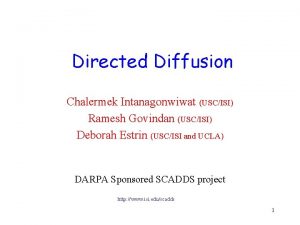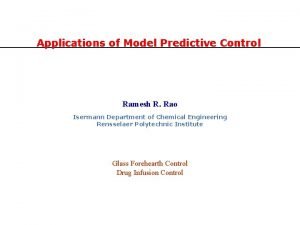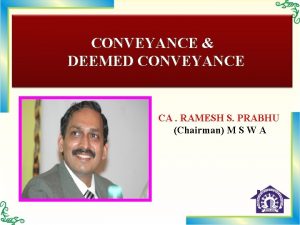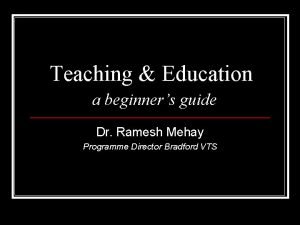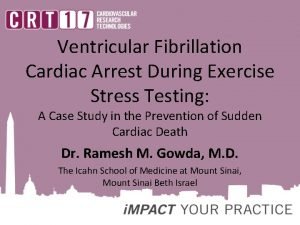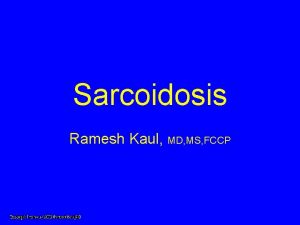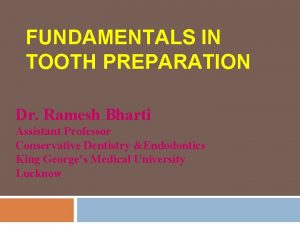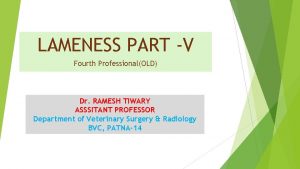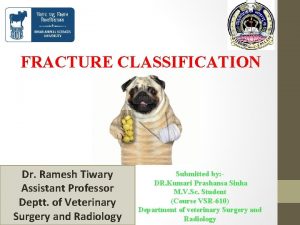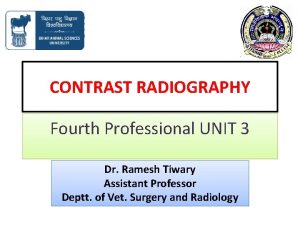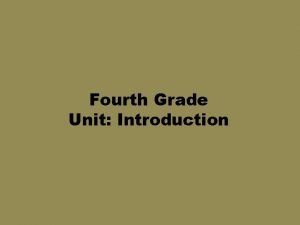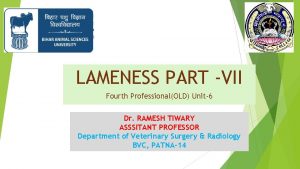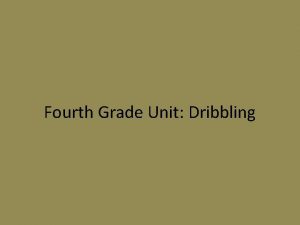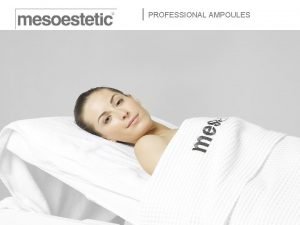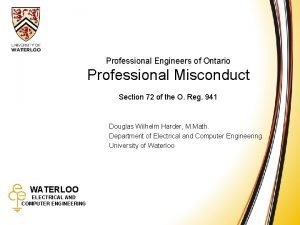RADIOLOGY3 Fourth Professional UNIT 3 Dr Ramesh Tiwary

















- Slides: 17

RADIOLOGY-3 Fourth Professional UNIT 3 Dr. Ramesh Tiwary Assistant Professor Deptt. of Vet. Surgery and Radiology

“PRODUCTION OF X-RAYS”

• Ionising Radiation • Particulate or corpuscular – alpha, beta particle, protons, electrons, neutrons, nuclear fragments. • Electromagnetic radiation – Heat waves, light waves, infra-red rays, U/V-rays, x-rays, gamma rays.

• Wave length to x-ray – 0. 1 to 0. 5 A 0 (1 A 0 = 1010 cm) • Energy - 25 to 125 Kev. • Diagnostic x-ray: 30 – 150 k. Vp. • Coherent scattering: A photon interacts with an object and changes its direction. Subject does not absorb the photon and photon energy does not changed. Degrade image quality, strike radiographer, increased personal exposure.

Interaction of Photons with Matters

Photoelectric effect • When x-ray photons interact with inner shell (K, L, M shell) electron of atom, free electron fly off as photoelectric and get absorbed in the body. Outer electrons shift to the inner shell gives off energy in the form of radiation called characteristic radiation or line radiation. • Photoelectric effect α z 3 and inversely proportional to 1/E 3. • By using high k. Vp photoelectric effect decrease thus patient dose decreased. • Photoelectric effect is responsible formation of image on radiographs of object.

• Bremstrahlung or breaking or General or white radiation – when electron passing through positive nucleus of target deflected or slow lose in kinetic energy • Compton effect: - Moderate or high energy photon encounters free electron of the outer shell of the atom. • Compton effect produces almost all the scatter radiation encountered in diagnostic radiology. • Compton effect of x-ray independent of atomic number of absorbing material.

X-RAY TUBE • It consists of a glass tube (12 -18 cm L, 9 cm D) which has been evacuated to produce a high vacuum and into which are sealed two electrodes, the cathode (-) and the anode (+) placed 1 -3 cm apart. Cathode Anode Glass Envelope CATHODE Spiral filament in focusing cup. Tungsten target set in anode face.

CATHODE. of the x-ray tube, its • Cathode: - Negative side filament consists of tungsten atomic no. 74 and melting point 33700 C. Ø Tungsten has little tendency to vaporise, thus it prolongs the life of the x-ray tube. Ø Focusing cup: - Filament is embedded in a concave metal shroud called focusing cup made of nickel or molybdenum.

ANODE • Positive side of the x-ray tube. • It is termed the target, because it is the origin of the X-ray beam it is also spoken of as the focus or focal spot. • 99% of kinetic energy in the collision converted into thermal energy and 1% irradiated as x-rays. • Cathode filament and its focusing cup are so constructed that the beam of electrons focused on this relatively small area.

Types of Anod • Stationary type – used in dental x-ray machine as portable x-ray units where high current power not required. • Consists of copper block embedded with tungsten rhenium alloy metal.

Rotating type • Rotating type –Consists of a molybdenum disc coated with a strip of tungsten –rhenium alloy. • Advantage over stationary type is better heat dissipation, provides larger target area for electron beam to interact. • Size of focal spot in x-ray machines varies from 0. 3 to 3 mm and angle should not less than 150.

Diagram Of A Rotating Anode Tube Rotating disc target of anode Glass Tube Emitted Rad Cathode

Heel effect • Heel effect: - Radiation intensity as high as 40% on the cathode side of the x-ray beam than on the anode side is called heel effect. • while taking radiograph of unequal thickness, thicker or denser side should be positioned towards the cathode. • Smaller angle of anode more pronounced heel effect. • When film size larger and focal film distance are less heel effect more noticeable.

Quantity of x-ray production Tube current (Milliamperage or m. A) – Increasing m. A increases the x-ray output. Tube potential (KVP): - If KVP is doubled the x-ray quantity increase by a factor of four. Increase in KVP by 15% would require a reduction in m. As by one half. Focal film distance: - X-ray intensity varies inversely to the squire of the distance between the target and focal spot.

Type of x-ray machines • Portable x-ray machine – 70 to 110 KV and 15 to 35 m. A. • Mobile x-ray machine - 90 to 150 KV and 40 to 300 m. A. • Fixed x-ray machine – 120 to 150 KV and 300 to 1000 m. A.

 Ramesh govindan usc
Ramesh govindan usc Ramesh r. rao
Ramesh r. rao Ramesh mehay
Ramesh mehay Ca ramesh prabhu contact number
Ca ramesh prabhu contact number Ramesh mehay
Ramesh mehay Ramesh mehay
Ramesh mehay Ramesh sitaraman
Ramesh sitaraman Ramesh sitaraman
Ramesh sitaraman Ramesh sitaraman
Ramesh sitaraman Cathvideo
Cathvideo Chlorambucil
Chlorambucil Introduction to angular
Introduction to angular Akamai http3
Akamai http3 Features of primary retention form
Features of primary retention form Bradford vts cbd question maker
Bradford vts cbd question maker Ramesh mehay
Ramesh mehay Unit 6 review questions
Unit 6 review questions Lpmde
Lpmde
